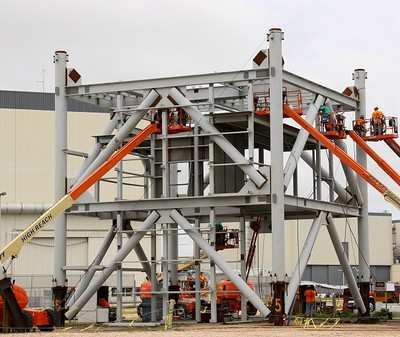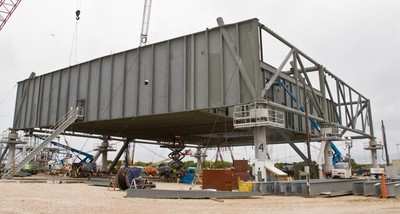Sat, Jul 11, 2009
Ares I Will Require A Redesigned Tower And Mobile Platform
By Wes Oleszewski
 As the stacking of the
Ares I-X test vehicle proceeds in High-bay 4 of the VAB at the
Kennedy Space Center, an almost inconspicuous group of structures
are growing outside in the Mobile Launch Platform parking area.
These primer-gray structures appear to be little more than a jumble
of huge pipes and giant steel walls, but they are actually the
launchers of tomorrow. Hidden in plain site, they are the
beginnings of the new lightweight Launch Umbilical Tower (LUT) and
Mobile Launch Platform (MLP) for the Ares I, NASA's proposed next
manned launch vehicle.
As the stacking of the
Ares I-X test vehicle proceeds in High-bay 4 of the VAB at the
Kennedy Space Center, an almost inconspicuous group of structures
are growing outside in the Mobile Launch Platform parking area.
These primer-gray structures appear to be little more than a jumble
of huge pipes and giant steel walls, but they are actually the
launchers of tomorrow. Hidden in plain site, they are the
beginnings of the new lightweight Launch Umbilical Tower (LUT) and
Mobile Launch Platform (MLP) for the Ares I, NASA's proposed next
manned launch vehicle.
Many of the first pieces that would make up the new launchers
arrived at KSC by barge beginning in February, and by late spring
the new MLP was taking shape and the base and lower levels of the
LUT were formed. Although both components will occupy nearly
the same space as their predecessors used on the Saturn V, the new
structures will weigh about two and a half million pounds less.
That's necessary because while the Ares I looks slender, it's
actually a heavyweight coming out of the VAB.

LUT Photo Credit NASA
Standing more than 340 feet tall, the Ares I will require a 345
foot tall tower to service its liquid fueled second stage as well
as for crew access to the Orion spacecraft. The problem is that the
launch vehicle's first stage, a five segment Shuttle derived SRB,
will be enormously heavy. As a result, the Ares I's projected
roll-out weight will be about 1.6 million pounds. Add the weight of
a current shuttle MLP of 8.8 million pounds plus a Saturn V era
style LUT weighing approximately 4 million pounds and the Ares I
would be rolling out 1.4 million pounds heavier than the
current crawler-transporters can lift. Although the Saturn V
configuration looked huge in comparison to the Ares I, the Saturn V
was transported to the pad empty. The gigantic moon rocket actually
tipped the scale in at just over one third of the Ares I's
projected roll-out weight. However, the launch weight for the Ares
I will only be about 2.2 million pounds, while the Saturn V lifted
off the pad at over 6.5 million pounds.

MLP Photo Credit NASA
Solving the Ares I roll-out weight problem required the
construction of a new lightweight MLP and LUT combination. The MLP
consists of a platform core mounted on tubular trusses. These
trusses stretch out to legs that connect to the hard points at
Launch Complex 39. The structure's tubular framework allows for pad
stability at a lesser weight while using the current
crawler-transporters. Likewise, the new LUT departs from the steel
girders used in the Apollo era tower and instead is constructed of
tubular steel. This tubular construction allows for girder-like
strength and stability at a far lower weight.
Basic construction on the lightweight MLP and LUT combination is
supposed to be done in the summer of 2010 with equipment
installation and testing going on for the next two years. The new
launcher is scheduled to be "Go" for use in 2012.
More News
Aero Linx: Florida Antique Biplane Association "Biplanes.....outrageous fun since 1903." That quote really defines what the Florida Antique Biplane Association (FABA) is all about.>[...]
Beyond Visual Line Of Sight (BVLOS) The operation of a UAS beyond the visual capability of the flight crew members (i.e., remote pilot in command [RPIC], the person manipulating th>[...]
Also: ForeFlight Upgrades, Cicare USA, Vittorazi Engines, EarthX We have a number of late-breaking news highlights from the 2024 Innovation Preview... which was PACKED with real ne>[...]
“For Montaer Aircraft it is a very prudent move to incorporate such reliable institution as Ocala Aviation, with the background of decades in training experience and aviation>[...]
Maximum Authorized Altitude A published altitude representing the maximum usable altitude or flight level for an airspace structure or route segment. It is the highest altitude on >[...]
 ANN's Daily Aero-Linx (04.13.24)
ANN's Daily Aero-Linx (04.13.24) ANN's Daily Aero-Term (04.13.24): Beyond Visual Line Of Sight (BVLOS)
ANN's Daily Aero-Term (04.13.24): Beyond Visual Line Of Sight (BVLOS) Airborne 04.09.24: SnF24!, Piper-DeltaHawk!, Fisher Update, Junkers
Airborne 04.09.24: SnF24!, Piper-DeltaHawk!, Fisher Update, Junkers Aero-News: Quote of the Day (04.14.24)
Aero-News: Quote of the Day (04.14.24) ANN's Daily Aero-Term (04.14.24): Maximum Authorized Altitude
ANN's Daily Aero-Term (04.14.24): Maximum Authorized Altitude





